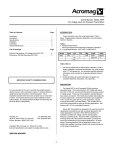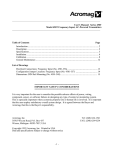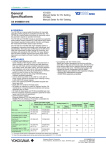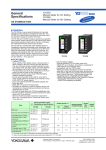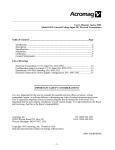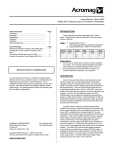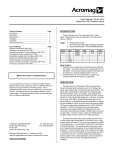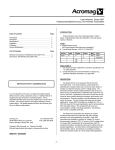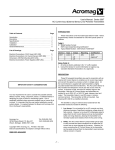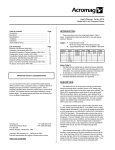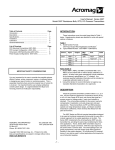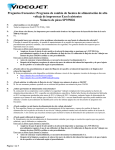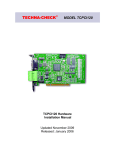Download - 1 - User`s Manual: Series 340I Model 340I DC-Powered
Transcript
_________________________________________________________________ User's Manual: Series 340I Model 340I DC-Powered Input Isolator _________________________________________________________________ Table of Contents Page Introduction.......................................................................................................................... 2 Description ........................................................................................................................... 2 Specifications........................................................................................................................ 3 Installation ............................................................................................................................ 5 Calibration ............................................................................................................................ 7 General Maintenance............................................................................................................. 7 List of Drawings Electrical Connections: (No. 4501-261). ............................................................................... 8 Dimensions: DIN Rail Mounting (No. 4501-262). ................................................................. 9 Electrical Connections: Power Supply Configurations (No. 4501-263) ................................ 10 Load Resistance Versus Supply Voltage (No. 4501-265) .................................................... 11 ================================= IMPORTANT SAFETY CONSIDERATIONS ================================== It is very important for the user to consider the possible adverse effects of power, wiring, component, sensor, or software failures in designing any type of control or monitoring system. This is especially important where economic property loss or human life is involved. It is important that the user employ satisfactory overall system design. It is agreed between the Buyer and Acromag, that this is the Buyer's responsibility. Acromag, Inc. 30765 South Wixom Road P.O. Box 437 Wixom, Michigan 48393-7037, USA Tel: (248) 624-1541 FAX: (248) 624-9234 Copyright 1993 Acromag, Inc. Printed in USA Data and specifications subject to change without notice 8500-334-B93K008 - 1 - Series 340I User's Manual Process Current Input Isolator _________________________________________________________________ _____________ INSTRUCTIONS: SERIES 340I Process Current Input Isolator, DC Powered INTRODUCTION: These instructions cover the model types listed in Table 1 below. Supplementary sheets are attached for units with special options or features. Table 1: A. Model Number Format : 340I-Input-Output-Mounting-Certification B. Typical Model Number: 340I-C1-Y-DIN-NCR Series -Input -Output -Mounting -Certification 340I -C1 -Y -DIN -NCR -Agency Approval 2 Notes (Table 1): 1. All units are factory calibrated for 4 to 20mA DC input and 4 to 20mA DC output (no "-C" suffix needed). 2. Consult the factory for current information on agency (e.g. Canadian Standards Association, etc.) approvals. DESCRIPTION: This DC powered input isolator accepts a 4 to 20mA DC input signal and provides an isolated 4 to 20mA DC output signal. The isolator operates from a wide supply range, has a low input burden, is RFI and EMI protected, and operates over a large temperature range with excellent temperature coefficients, which minimize effects from the harsh plant environment. The Series 340I is a DIN-rail mounted, process current isolator, designed to be used as another functional component to provide the user with a modular approach to the varied applications in the field. Unlike the Series 270I which is a two-wire loop-powered isolator, the Series 340I is a three-wire isolator. That is, Series 340I Isolators require a separate power supply connection, while the output signal and DC power share a common lead. The small package size, low power requirements, and wide supply range offers maximum flexibility to the user. As a threewired DC powered device, it can also be used in critical applications that require the use of redundant supplies. The Series 340I includes reverse polarity protection, current limiting, and operates from a single 10V to 36V DC supply. In applications requiring only a single isolator, the 340I can use available DC power, or it can be wired to an optional Series 35PS power supply module. The Series 35PS power supply module receives it's power from either 115V AC or 230V AC. Applications requiring multiple isolators at a single location can more efficiently share a single DC supply. The modular approach of this design and companion Acromag flat-pack modules allows additional transmitters, input modules, isolators, and alarms to be easily integrated, as required. See Drawing 4501-261 for a simplified Series 340I schematic. - 2 - Series 340I User's Manual Process Current Input Isolator _________________________________________________________________ _____________ Input wiring is inserted in the bottom of the unit, while output and power wiring is inserted at the top of the unit. Screws to secure the wiring are located on the front panel. Connectors are screw-clamp type and accept wire size up to #14 AWG. Key 340I Features: * True Galvanic (Transformer) Isolation * Wide Ambient Temperature Range * 1-Inch Wide DIN Mounted Package * DC Powered, Wide Supply Range * Allows Use of Redundant Supplies * Low Input Burden (less than 1.5V) * Highly Accurate and Stable * No Load Trimming Required * Current Limiting Included * 0-500 ohm Load Range (15V supply) SPECIFICATIONS: Function: This DC powered isolator accepts a 4 to 20mA DC input, has input circuit isolation, and provides a 4 to 20mA DC output. The output and DC power share a common terminal (3Wire connection). The Zero and Span trim adjustments utilize 15-turn potentiometers accessible from the front of the unit. This isolator is DIN-rail mounted. MODEL/SERIES: 340I- (Color coded with a white label) INPUT: -C1: 4 TO 20mA DC, with an input drop less than 1.5V at full-scale. IMPORTANT: Input current must not exceed 100mA or damage to the unit could occur. Isolation: The input circuit is electrically isolated from the output and power circuits, allowing the input to operate at up to 250V AC, or 354V DC off ground, on a continuous basis (will withstand 1500V AC dielectric strength test for one minute without breakdown). This complies with test requirements outlined in ANSI/ISA-S82.01-1988 for the voltage rating specified. OUTPUT: -Y: 4 to 20mA DC. The output shares a common with the power supply. NOTE: A voltage output option is not available for the Series 340I. Instead, specify Model 350T-C1-Vx-NCR-C if this is a requirement of your application. Load Resistance Range Equation: The maximum load resistance is a function of available power supply voltage as follows (refer to Drawing 4501-265): R-Load (Maximum) = (Minimum VDC supply - 5.0V) / 0.02A That is, with a 10.0V DC supply, R-Load = 0 to 250 ohms with a 15.0V DC supply, R-Load = 0 to 500 ohms with a 24.0V DC supply, R-Load = 0 to 950 ohms - 3 - Series 340I User's Manual Process Current Input Isolator _________________________________________________________________ _____________ Output Limiting: Output current is limited to 27mA, nominal. Output Ripple: Less than +/-0.1% of the maximum output span. Power: 10.0V to 36.0V DC, 27mA, nominal. The external DC power supply is connected between the output (P) and (-) terminals. The output shares a common connection with the power supply. The current specified is for rated supply inputs and full-scale output. Supply current is limited to 34mA, maximum. Diode installed in isolator provides reverse polarity protection. IMPORTANT: Do not exceed 36V DC peak, to avoid damage to the isolator. Power Supply Effect: DC Volts: less than +/-0.001% of output span per volt DC change in supply. 60/120Hz Ripple: less than +/-0.01% of span per volt peak-to-peak of power supply ripple. Reference Test Conditions: Input/Output current: 4 to 20mA; output load 250 ohms; 77oF (25oC); +15V DC supply. Accuracy: Better than +/-0.1% of output span. This error includes the combined effects of isolator repeatability, hysteresis, terminal point linearity and adjustment resolution. Does not include sensor error. Ambient Temperature Range: -13oF to 185oF (-25oC to 85oC). Ambient Temperature Effect: Less than +/-0.003% of output span change per oF (+/-0.005% per oC) over the ambient temperature range for reference test conditions. This specification includes the combined effects of zero and span over temperature. Bandwidth: -3dB at 50Hz, typical, with 500 ohm load. Response Time: For a step input, the output reaches 98% of output span in 25ms, typical, with 500 ohm load. Noise Rejection: Normal Mode: -6dB at 60 Hz, typical, with 500 ohm load. Common Mode: -95dB at 60Hz, typical, with 500 ohm load. RFI Resistance: Less than +/-0.5%, of output span with RFI field strengths of up to 10V/meter at frequencies of 27, 151 and 467 MHz. EMI Resistance: Less than +/-0.25% of output span effect with switching solenoids or commutator motors. Surge Withstand Capability (SWC): Input/Output terminations rated per ANSI/IEEE C37.901978. Unit is tested to a standardized test waveform that is representative of surges (high frequency transient electrical interference), observed in actual installations. - 4 - Series 340I User's Manual Process Current Input Isolator _________________________________________________________________ _____________ Construction: Printed Circuit Boards: Military grade FR-4 epoxy glass circuit board. Terminals: Compression type, wire size 14 AWG maximum. Case: Self-extinguishing NYLON Type 6.6 polyamide thermoplastic UL94V-2, color black. General Purpose, NEMA Type 1 enclosure. Printed Circuit Board Coating: Fungus resistant acrylic conformal coat. Mounting Position: Position insensitive. MOUNTING: -DIN: General Purpose Housing, DIN-Rail Mount - "G" & "T" rails. "G" Rail (32mm), Type EN50035; "T" Rail (35mm), Type EN50022. Refer to Drawing 4501-262 for outline and clearance dimensions. Shipping Weight: 1 pound (0.45Kg) packed. CERTIFICATION: Consult the factory for current information on the availability of agency (e.g. Canadian Standards Association, Factory Mutual, etc.) approvals. -NCR: No Certification Required. INSTALLATION: The isolator is packaged in a general purpose type of enclosure. Use an auxiliary enclosure to protect against unfavorable environments and locations. Maximum operating ambient temperatures should be within -13 to 185oF (-25 to 85oC) for satisfactory performance. If the has been calibrated, it is ready for installation. Connect as shown in the connection diagram of Drawing 4501-261. To verify calibration, refer to the "CALIBRATION" section. Mounting: Mount isolator assembly - refer to Drawing 4501-262 for DIN-rail mounting and clearance dimensions. DIN Rail Mounting: Using suitable fastening hardware, secure the DIN rail to the designated mounting surface. A transmitter, can be mounted to either the "T" or "G" Rail. Installation of the transmitter to the rail depends on the type of DIN rail used. Units can be mounted side by side on 1.0 inch centers, if required. "T" Rail (35mm), Type EN50022: To attach a transmitter to this style of DIN rail, angle the top of the unit towards the rail and locate the top groove of the adapter over the upper lip of the rail. Firmly push the unit towards the rail until it snaps solidly into place. To remove a transmitter, insert a screwdriver into the lower arm of the connector and pull downwards while applying outward pressure to the bottom of the unit. - 5 - Series 340I User's Manual Process Current Input Isolator _________________________________________________________________ _____________ "G" Rail (32mm), Type EN50035: To attach a transmitter to this style of DIN rail, angle the unit so that the upper groove of the adapter hooks under the top lip of the rail. Firmly push the unit towards the rail until it snaps solidly into place. To remove a transmitter, pull the lower part of the unit outwards until it releases from the rail, lift unit from rail. Electrical Connections: The wire size used to connect the unit to the control system is not critical. All terminal strips can accommodate wire from 14-26 AWG. Strip back the insulation 1/4 inch on each lead before installing it into the terminal block. Input wiring may be either shielded or unshielded twisted pair. Output wires should be twisted pair. Since common mode voltages can exist on signal wiring, adequate wire insulation should be used and proper wiring practices followed. It is recommended that output and power wiring be separated from the signal wiring for safety, as well as for low noise pickup. 1. Power: Connect DC power supply per connection diagram, refer to Drawing 4501261. This isolator operates from DC power supplies only. Power supply voltage is not critical and should normally be from 10 to 36V DC. The supply voltage must not exceed 36V, or damage to the unit may occur. The power supply voltage must be adequate to furnish full-scale current to the load(s). Rated variations in power supply voltage or load resistance have negligible effect on isolator accuracy. Refer to "Power" in the preceding "SPECFICATIONS" section for current requirements. The minus (-) power supply lead and the minus (-) output lead share a common terminal. Power connections are reverse polarity protected. Refer to Drawing 4501-263 for other power supply configurations. Ripple and Noise: Power supply ripple at 60Hz/120Hz is reduced at the load by the isolator. The ripple at the load will be less than +/-0.01% of span per volt peak-topeak of power supply ripple. 2. Output: Connect output per connection diagram, refer to Drawing 4501-261. Load range is a function of the module's power supply voltage; refer to "Output" in the preceding "SPECIFICATIONS" section (see Drawing 4501-265). The output shares a common with the power supply. 3. Grounding: The transmitter housing is plastic and does not require an earth ground connection. 4. Input: Input is 4 to 20mA DC. Connect input per connection diagram, observe proper polarity. NOTE: The input circuit is electrically isolated from the output/power circuit allowing the input to operate up to 250V AC or 354V DC off ground on a continuous basis. - 6 - Series 340I User's Manual Process Current Input Isolator _________________________________________________________________ _____________ CALIBRATION: All units are calibrated and checked for proper performance at the factory before they are shipped. The calibration example below is provided for reference. Isolator - Adjustment Procedure: Connect the isolator as shown in the recommended calibration connections of the connection diagram (Drawing 4501-261). The input current source must be adjustable over the entire input range of the unit and settable to an accuracy of 0.05% or better for proper results. The Zero and Span adjustments are accessible on the front panel of the isolator, see Drawing 4501-261 for location. The Zero and Span trim provided are not wide-range adjustable and are suitable for fine tuning only. The screwdriver blade used to adjust the potentiometers should not be more than 0.1 inch (2.54mm) wide. Isolator - Calibration Example: MODEL : 340I-C1-Y-DIN-NCR Input : 4 to 20mA DC Output: 4 to 20mA DC 1. Set the input source to 4.000mA. Adjust the Zero (Z) pot until the output reads 4.000mA DC (NOTE: If you have trouble reaching zero, you may have to first set the span near 16.000mA). 2. Set the input source to 20.000mA. Adjust the Span (S) pot until the output reads 20.000mA DC. 3. Repeat steps 1 and 2 until the readings converge. 4. Check the midpoint by setting the input source to 12.000mA. The output should read 12.000mA +/-0.016mA DC. The instrument is now calibrated. GENERAL MAINTENANCE: The isolator contains solid-state components and requires no maintenance except for periodic cleaning and calibration verification. When a failure is suspected, a convenient method for identifying a faulty isolator is to exchange it with a known good unit. It is highly recommended that a non-functioning isolator be returned to Acromag for repair, since Acromag makes use of tested and burned-in parts, and in some cases, parts that have been selected for characteristics beyond that specified by the manufacturer. Further, Acromag has automated test equipment that thoroughly checks the performance of each isolator. - 7 -











